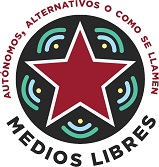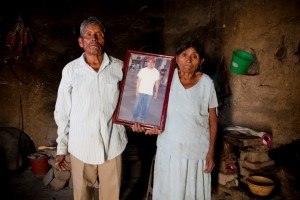Sorry, this entry is only available in Español. For the sake of viewer convenience, the content is shown below in the alternative language. You may click the link to switch the active language.
COMUNICADO URGENTE
19 de abril 2011
ASESINAN EN LA SIERRA DE PETATLAN AL CAMPESINO ECOLOGISTA
JAVIER TORRES CRUZ Y HIEREN A SU HERMANO FELIPE
Después de dos años y medio de feroz hostigamiento y persecución, finalmente el día de ayer lunes 18 de abril del 2011 a las 5:30 de la tarde, fue asesinado por sicarios al servicio de Rogaciano Alba Álvarez, el campesino ecologista Javier Torres Cruz, de 30 años de edad.
La noticia nos fue inicialmente dada a conocer por la Sra. Marcelina Torres Cruz, hermana del ahora occiso, mediante una llamada telefónica, donde nos informó que su hermano Javier había sido emboscado cerca de La Morena. Esta información nos fue confirmada el día de hoy, vía telefónica también, por su hermano Alejandro Torres Cruz, quien reafirmó que Javier, de manera extraña, se trasladaba por el lugar conocido como “Puerto de la Mosca”, entre las comunidades de La Morena y La Barranca, en la Sierra del municipio de Petatlán, cuando fue recibido a balazos por un grupo de hombres de apellido Arreola, entre otros, que fueron identificados como sicarios al servicio de Rogaciano Alba Alvarez (actualmente preso en el Penal de la Palma acusado de delincuencia organizada, delitos contra la salud y portación de armas de fuego de uso exclusivo del Ejército). Agregó que al ser informados vía radio de lo que estaba sucediendo, los hermanos Torres acudieron en auxilio de Javier, siendo recibidos también a tiros, resultando herido Felipe de los mismos apellidos. De inmediato, en Petatlán, parte de la familia Torres pidió auxilio a la Policía Estatal y al Cuartel Militar del 19 Batallón, pero les fue negada la petición con el argumento de que “no querían meterse en problemas”, sin explicar con quien.
Cómo fue de conocimiento público en su oportunidad, Javier Torres Cruz, agobiado por las constantes amenazas, agresiones y el asesinato de algunos de sus familiares por despojarlos de su tierra, decidió interponer una demanda penal contra Rogaciano Alba Alvarez, por el asesinato de la defensora de derechos humanos Digna Ochoa y Plácido. Desde entonces, la seguridad de el mismo y su familia había venido siendo amenazada y cada vez era más frágil, especialmente después de su secuestro e intento de desaparición en diciembre del 2008.
A raíz de lo anterior, el 21 de diciembre del 2008, la Comisión Interamericana de Derechos Humanos acordó el otorgamiento de medidas cautelares para Javier Torres Cruz, las cuales fueron reclamadas por él mismo el 7 de agosto del 2009 ante el Titular del Ministerio Público de Azueta de la Procuraduría de Justicia del Estado de Guerrero quien se presentó en la comunidad de La Morena para tomarle su declaración ministerial sobre la Averiguación Previa AZUE/PETA/111/2008, las cuales nunca le fueron otorgadas de manera dolosa.
Recientemente, la familia Torres había descubierto que atrás de un alarmante deterioro del estado de salud de Javier, había un intento de envenenamiento por parte de su esposa Adela Mojica Villa, quien a su vez, antes de huir de la comunidad, les manifestó que recibía órdenes de “los Arreola”, quienes al parecer tienen amenazada a su familia. Alejandro Torres manifestó que el día de ayer es probable que Javier haya sido citado por su esposa en el lugar a donde se dirigía para ver a sus hijos y aclarar su situación conyugal.
El asesinato de Javier Torres Cruz es resultado de la estrategia de despojo y explotación de los grupos de poder económico y político, que en contubernio con los malos gobiernos, es decir, la verdadera delincuencia organizada, mantienen una guerra de exterminio de pueblos y comunidades en distintos lugares del país y en particular en la Sierra de Guerrero.
Mientras el Ejército Mexicano ha mantenido una presencia intimidante y violatoria de los derechos de las comunidades mediante incursiones y persecuciones constantes, los gobiernos municipales, estatal y federal se mantienen al margen y deliberadamente desatienden su obligación de garantizar la seguridad pública y el ejercicio de los derechos humanos, así como las demandas y necesidades de los pueblos, dejando a la población a merced de la violencia que los despoja de sus tierras y recursos naturales, les impone el cultivo y consumo de enervantes y no les deja otra opción de vida más que la de ponerse al servicio de las mafias de la delincuencia para sobrevivir y no ser asesinados.
Javier Torres se resistió hasta donde pudo, pero finalmente sucumbió a la represión de sus enemigos dirigidos por Rogaciano Alba Alvarez, encubiertos por el Estado; a la traición de su propia esposa víctima del chantaje y el terror de las amenazas contra su familia; al desprecio e indiferencia cómplice del Estado que nunca le otorgó las medidas cautelares solicitadas ni los servicios que su comunidad reclama para romper el cerco de la marginación.
Javier Torres es una víctima más de la criminalización de la lucha social y de la llamada guerra del narco, de esa guerra de capitales oscuros donde el Estado ha tomado partido y el Gobierno de Calderón es parte de los contendientes, coludido con los grupos de poder político y económico integrados en las cúpulas de los partidos y en los grupos empresariales.
Javier Torres Cruz ha sido liquidado, asesinado, pero la lucha contra el despojo, la explotación, la represión y el desprecio se mantiene viva en La Sierra de Guerrero.
Por lo anterior, demandamos:
– Alto al hostigamiento a la familia Torres de La Morena, protección y otorgamiento inmediato de medidas cautelares a los sobrevivientes.
– Que se castigue a los asesinos de Javier Torres Cruz.
– Que se investigue debidamente y se aclaren los hechos del 16 de febrero del 2010, se deslinden responsabilidades, se aclare la situación jurídica de los presos Anselmo Torres Quiróz y Huber Vega Correa y se castigue a los agresores y asesinos de Adolfo Torres Rosas.
– Que no se utilice el discurso de la lucha contra el narcotráfico para encubrir actos de hostigamiento e intimidación en contra de las comunidades de la Sierra de Guerrero, se transparente la presencia militar en la región y se esclarezca la presencia de paramilitares con informes fidedignos de sus acciones y resultados.
– La salida inmediata del Ejército Mexicano de pueblos y ciudades de la Sierra de Guerrero, el regreso a sus cuarteles, castigo a los militares culpables de violaciones de derechos humanos y reparación de los daños causados a comunidades, organizaciones sociales y familias.
Llamamos a las organizaciones sociales y organismos civiles y de defensa de derechos humanos a solidarizarse e integrarse a las acciones de denuncia y solidaridad.
TALLER DE DESARROLLO COMUNITARIO
COLECTIVO CONTRA LA TORTURA Y LA IMPUNIDAD
Chilpancingo, Gro. a 19 de abril del 2011
SINOPSIS DE LOS ANTECEDENTES DEL ASESINATO DE JAVIER TORRES CRUZ
El 19 de septiembre del 2007 Javier Torres Cruz y su tío Isaías Torres denunciaron ante la PGJDF, a Rogaciano Alba Álvarez como presunto autor intelectual del asesinato de la abogada Digna Ochoa y Plácido el día 19 de octubre del 2001.
El día 13 de noviembre de 2008 en la madrugada las familias de la comunidad de La Morena fueron sujetas a un operativo militar al mando del mayor Rojas Arizmendi o Rojas Méndez, con unos 100 elementos del batallón 19 de infantería en el que entraron y catearon casas en busca de Javier, Felipe y Alejandro Torres Cruz y amenazaron a las mujeres. Les sustraen documentos personales y roban algunas pertenencias Según los testimonios los militares llegaron en 8 vehículos y colocaron 3 vehículos armados apuntando a las casas. Iban acompañados por civiles armados del grupo de Rogaciano Alba Álvarez.
El día 13 de noviembre a las 22:00 horas llegaron unos 30 civiles armados encapuchados quienes se metieron a las casas deshabitadas y se retiraron durante el amanecer del día 14.
El 18 de noviembre a las 17:00 horas llegaron 9 vehículos con aproximadamente 70 policías ministeriales al mando del coordinador operativo de la Costa Grande, capitán Darío de la Rosa Segura, quienes pidieron ver las casas donde habían entrado los militares. Se retiraron después de una hora.
El día 3 de diciembre del 2008 fue detenido en un retén del Ejercito, ubicado en San Luis La Loma. Según el testimonio de Javier, los soldados lo detienen, le vendan los ojos y se lo llevan a un lugar desconocido. En la noche lo entregan a particulares, quienes lo torturan (golpes en todo el cuerpo, amenazas) y lo interrogan, entre otras cosas acerca de la denuncia interpuesta en contra de Rogaciano Alba Álvarez. Lo llevan a un lugar desconocido en el campo, donde lo tienen hasta el día 7 de diciembre. Durante todo el tiempo permanece vendado de los ojos, golpeado, no recibe alimentos ni agua y siente que lo iban a matar. El día 7 le quitan la venda (quizá pensando que ya no iba a poder moverse) y en la madrugada en un momento de descuido Javier empieza a correr y logra escapar.
Reconoce que se encontraba en la región de Coyuquilla. Es perseguido durante varios días, hasta que el día 13 de diciembre llega a la región donde vive y donde según él, no era fácil que entraran sus persecutores. Relata que lo perseguían muchas personas, que se utilizó un avión, que lo balacearon con la intención de matarlo.
El día 13 de diciembre llega a su comunidad, se mantiene escondido por razones de seguridad. Hasta el día 15 la familia da a conocer que Javier se había escapado de sus captores.
El día 20 de diciembre una Misión de Observación acude a La Morena para entrevistarse con Javier, recabar el testimonio y constatar posibles huellas de tortura. La Comisión de Derechos Humanos del Estado de Guerrero acompaña la misión y realiza la documentación de la situación de Javier Torres Cruz.
El día 22 de enero, a petición expresa de Javier, se realiza otra visita a la comunidad. La familia informa de que hay amenazas de muerte contra Javier y toda la familia y se teme que gente de Rogaciano Alba Álvarez y el ejército puedan actuar en contra de la familia.
El día 27 de enero informa Javier Torres Cruz, que desde el sábado 24, se encuentra en la comunidad de La Morena, Municipio de Petatlán un grupo de 25 soldados que llegaron a pie y desde entonces se mantienen acampados a 200 metros de su casa sin hablar con su familia y rondando la comunidad. Las mujeres, el maestro y los niños que están en el pueblo, se mantienen en sus casas, sin salir por el temor de que les hagan algo. Los soldados se retiran unos días después sin dar explicaciones.
El viernes 8 de Mayo de 2009, se publica en periódicos del Estado, información de la PGJE que vincula a Javier Torres Cruz con la desaparición de Álvaro Rosas Martínez, presidente del PRD en Petatlán quien fue privado de su libertad y posteriormente encontrado asesinado. Posteriormente el entonces Procurador Murueta se desdice.
El 16 de febrero del 2010, un comando de más de 100 soldados del Ejército Mexicano a bordo de vehículos Hummer y de los llamados “mercedes” incursionaron en el área conocida como “El infierno”, cerca de las comunidades deshabitadas de Rancho Nuevo y Las Humedades, donde parte de los campesinos de la comunidad de La Morena tienen sus tierras de labor, lo que dio como resultado la detención de dos personas, un muerto y un herido. Javier Torres Cruz y Narciso Torres Rosas, manifestaron que los efectivos del Ejército llegaron disparando contra las personas que se encontraban trabajando en sus parcelas, por lo que algunos de ellos corrieron para ponerse a salvo, no pudiendo hacerlo Anselmo Torres Quiróz de 78 años y Huber Vega Correa por no conocer bien el lugar. En esa persecución hirieron a Isaías Torres Rosas y murió Adolfo de los mismos apellidos. Lo anterior fue constatado por una Misión de Observación Civil que el día miércoles 17 de febrero del 2010, acudió a la Comunidad de La Morena.
El martes 7 de diciembre del 2010, alrededor de 35 efectivos militares a bordo de 3 carros Hummer incursionaron en la comunidad de La Morena, ubicada en el municipio de Petatlán, Guerrero, haciendo uso de sus armas de fuego y provocando el pánico y la zozobra entre los habitantes y como ya es costumbre, mientras los hombres y adolescentes corrieron hacia los cerros cercanos, las mujeres, niños y ancianos se concentraron en sus casas, siendo allanadas por los militares. Al parecer la partida militar llegó por el lado de la comunidad de El Camalote, por un camino recién rehabilitado y proviene del 19 Batallón con sede en Petatlán.
El 21 de enero del 2011 la Comisión Nacional de Derechos Humanos informa a Javier Torres Cruz que la SEDENA niega la detención realizada por militares en el 2008.
En el mes de marzo el Dr. Pablo Sandoval Cruz, verifica la salud de Javier Torres Cruz y diagnostica: Síndrome sugestivo de envenenamiento. Depresión aguda en fase regresiva. Delirio de Persecución, Anemia y Avitaminosis.
TALLER DE DESARROLLO COMUNITARIO
COLECTIVO CONTRA LA TORTURA Y LA IMPUNIDAD
Chilpancingo, Gro. a 19 de abril del 2011






